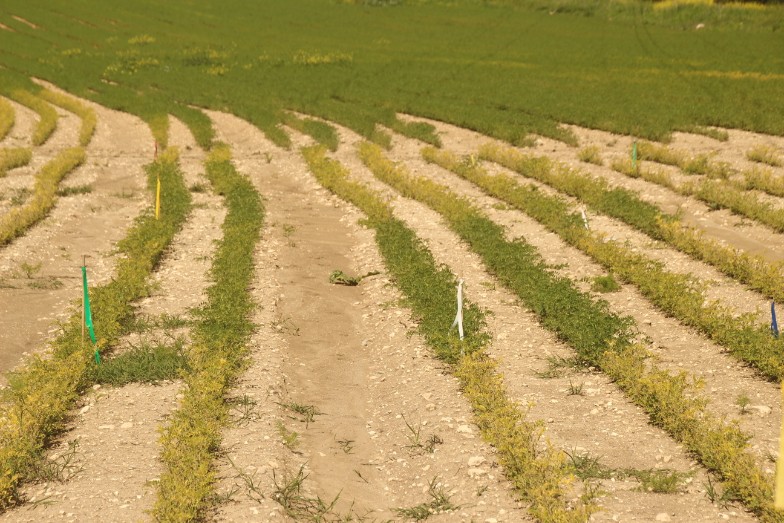The Eriochrome cyanine R staining method for aluminum toxicity assay
The method is simple and straightforward as described by Wang et al. (Aust. J. Agric. Res. 57(1) 89–100, 2006). A minimal extract from that paper is presented below:
From Wang et al. (Aust. J. Agric. Res. 57(1) 89–100, 2006):
Andrzej Anio, of the Plant Breeding and Acclimatization Institute, Radzikow, 05-850 Blonie, Poland, also published the details of the method in ‘Plant Breeding News’ (online):
The test used in our experiments is based on the assumption that inhibition of plant growth by Al is not observed before root systems develop. Since inhibition of root elongation is the first visible symptom of Al injury, direct reference to this process in selection seems to be a reasonable approach.
The pulse test is based on exposure of roots to short Al shock after which the effect on root elongation is recorded. In the method used in our laboratory, the Al pulse principle of MOORE ET AL.1976 was combined with the staining technique developed by POLLE ET ALL 1978. Seeds were sterilized with 0.1%Hg2 Cl2 aqueous solution for 10 min., rinsed thoroughly with water, and germinated overnight on filter paper in Petri dishes. Sprouted seeds were sown the next day on polyethylene net fixed in lucite frames. Styrofoam blocks were attached to the frames with rubber bands and floated on the surface of a vigorously aerated nutrient solution. Containers with nutrient solution were placed in water bath at 25oC under continuous light (12 w/m). Nutrient solution of the following composition was used: 0.4 mom calcium chloride, 0.65 mom potassium nitrate, 0.25 mom magnesium chloride, 0.01 mom ammonium sulfate and 0.04 mom ammonium nitrate. Four day-o1d seedlings were transferred to the same nutrient medium supplied with Al, in the form of aluminum chloride, at concentration indicated in the experiments. After 24 hours of incubation in the medium containing Al, seedlings were thoroughly washed for 2-3 min. in running water and transferred to nutrient solution without Al for 48 h. Seedlings were removed from nutrient solution, again washed with tap water, and stained with 0.1 % aqueous solution of Eriochrome cyanine R for 10 min. The excess dye was washed after staining with tap water. The root regrowth after Al shock (or additional root growth) was easily assessed. Seedlings with apical meristems, damaged by a given Al pulse, had intensively stained root tips while those not damaged by Al had a stained section of root followed by white root tip which developed after Al shock. The dye is nontoxic to roots at the concentration used and at the time stain was applied. During all stages of growth, and particularly during Al treatment, nutrient solution was maintained at pH 4.5, adjusted with 0.1 M HCl. At the ratio of approximately 20 ml of nutrient solution per seedling, changes of pH of the medium were minimal during 24 h of Al treatment. Seedlings after the test were still viable and could be transplanted for seed increase. Aluminum concentration in nutrient solution causing irreversible damage to root apical meristem during pulse treatment is a measure of tolerance of tested genotype.
The described test was used for screening parental cultivars and hybrid populations. The results correspond very well with cultivars of known Al resistance. Selected seedlings were transplanted to the field for seed increase or further crossing. The test gives reproducible results provided that proper conditions (temperature, pH, Al concentration, time of exposure to Al) are controlled.
This test was used successfully in our program directed at development of winter wheat strains with introduced Al-tolerance from Brazilian, extensive spring cultivar BH 1146. We can now offer to the wheat breeders a set of strains with agronomic characters at the level of top cultivars on the list and Al-tolerance similar to BH 1146.
Several major genes control Al tolerance in hexaploid wheat and the character is dominant and heritable, therefore, selection for Al tolerance in wheat would be effective.
The described screening test does not allow the discrimination between Al-tolerant homozygotes and heterozygotes. Moreover, Al-tolerance in hexaploid wheat is a genetically complex character and sensitive segregants were observed in many generations after cross. This obstacle was solved by development of DH lines in F3 /F4 generations.
References
Moore D P, Kronstad W E and Metzger R J 1976. Screening wheat for aluminum tolerance. In: Plant Adaptation to Mineral Stress in Problem Soils. Ed. M J Wright. Cornell Univ Agric. Exp. Sta.,Ithaca,NY.
Polle E, Konzak A F and Kittric J A 1978 Visual detection of aluminum tolerance levels in wheat by hematoxylin staining of seedling roots. Crop Sci. 18, 823-827.








